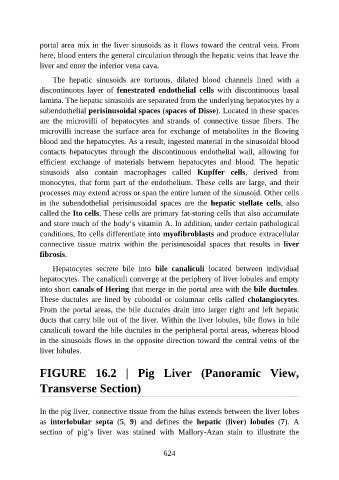Page 625 - Atlas of Histology with Functional Correlations
P. 625
portal area mix in the liver sinusoids as it flows toward the central vein. From
here, blood enters the general circulation through the hepatic veins that leave the
liver and enter the inferior vena cava.
The hepatic sinusoids are tortuous, dilated blood channels lined with a
discontinuous layer of fenestrated endothelial cells with discontinuous basal
lamina. The hepatic sinusoids are separated from the underlying hepatocytes by a
subendothelial perisinusoidal spaces (spaces of Disse). Located in these spaces
are the microvilli of hepatocytes and strands of connective tissue fibers. The
microvilli increase the surface area for exchange of metabolites in the flowing
blood and the hepatocytes. As a result, ingested material in the sinusoidal blood
contacts hepatocytes through the discontinuous endothelial wall, allowing for
efficient exchange of materials between hepatocytes and blood. The hepatic
sinusoids also contain macrophages called Kupffer cells, derived from
monocytes, that form part of the endothelium. These cells are large, and their
processes may extend across or span the entire lumen of the sinusoid. Other cells
in the subendothelial perisinusoidal spaces are the hepatic stellate cells, also
called the Ito cells. These cells are primary fat-storing cells that also accumulate
and store much of the body’s vitamin A. In addition, under certain pathological
conditions, Ito cells differentiate into myofibroblasts and produce extracellular
connective tissue matrix within the perisinusoidal spaces that results in liver
fibrosis.
Hepatocytes secrete bile into bile canaliculi located between individual
hepatocytes. The canaliculi converge at the periphery of liver lobules and empty
into short canals of Hering that merge in the portal area with the bile ductules.
These ductules are lined by cuboidal or columnar cells called cholangiocytes.
From the portal areas, the bile ductules drain into larger right and left hepatic
ducts that carry bile out of the liver. Within the liver lobules, bile flows in bile
canaliculi toward the bile ductules in the peripheral portal areas, whereas blood
in the sinusoids flows in the opposite direction toward the central veins of the
liver lobules.
FIGURE 16.2 | Pig Liver (Panoramic View,
Transverse Section)
In the pig liver, connective tissue from the hilus extends between the liver lobes
as interlobular septa (5, 9) and defines the hepatic (liver) lobules (7). A
section of pig’s liver was stained with Mallory-Azan stain to illustrate the
624

